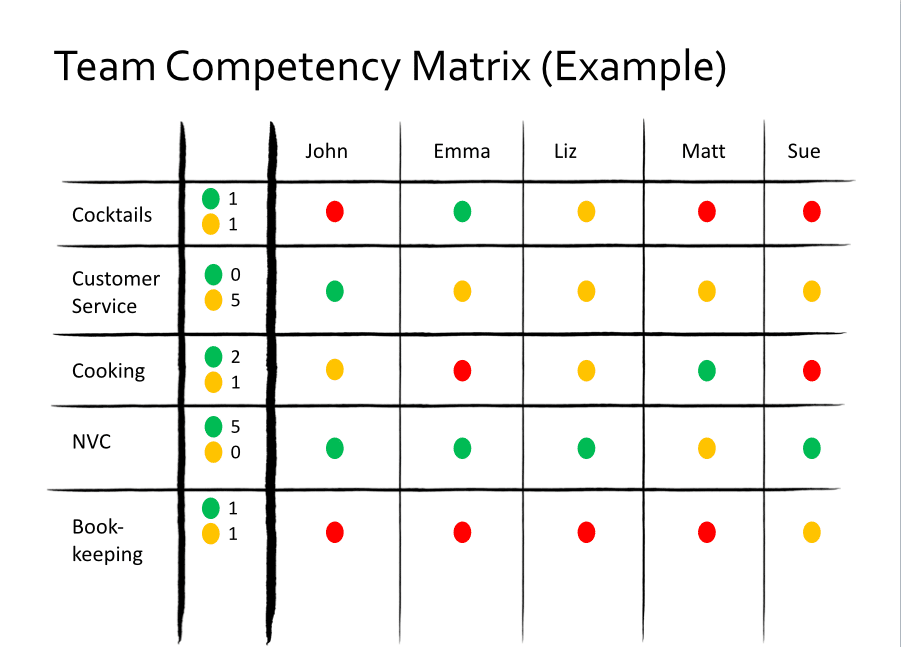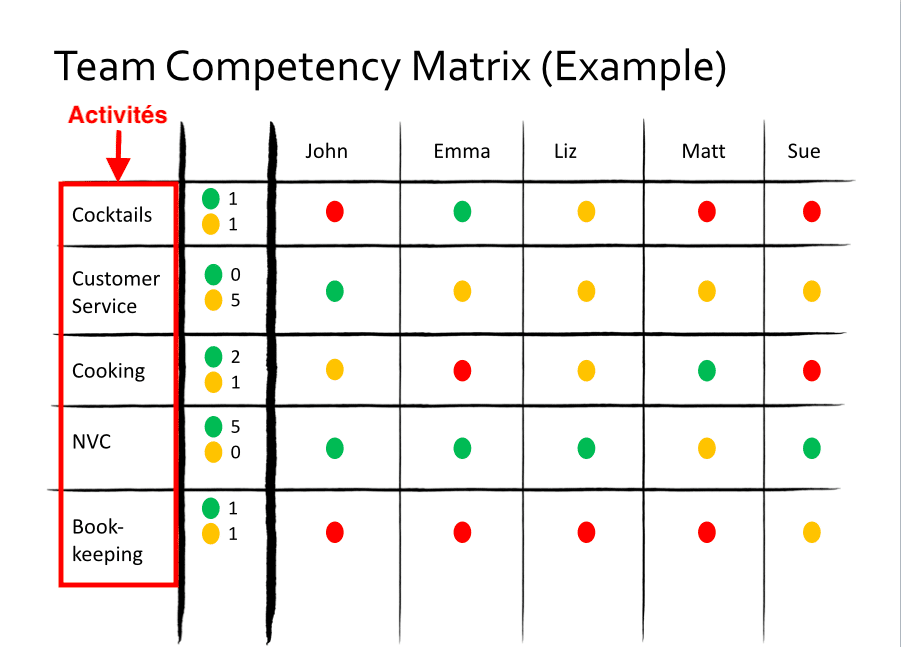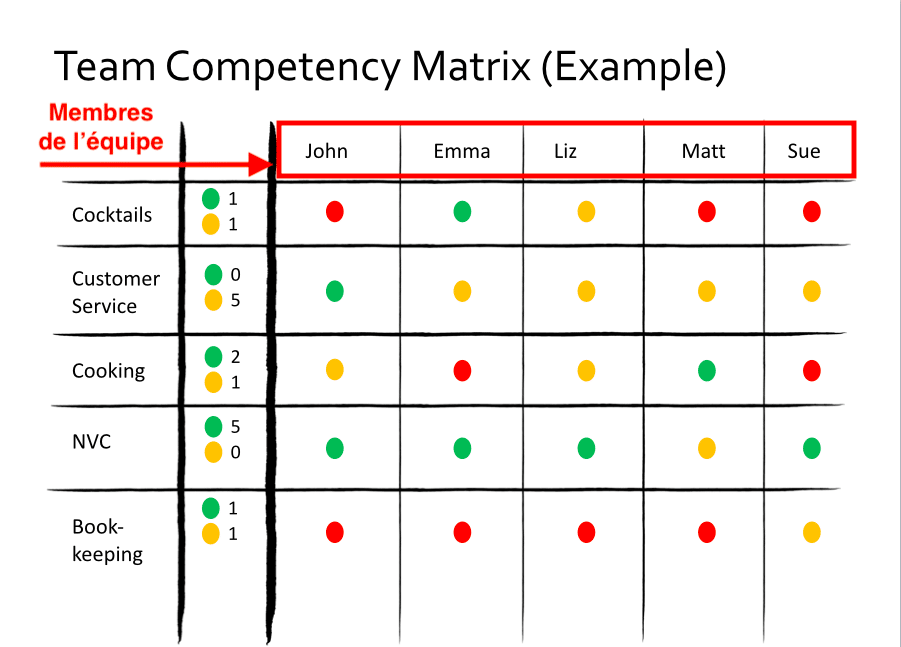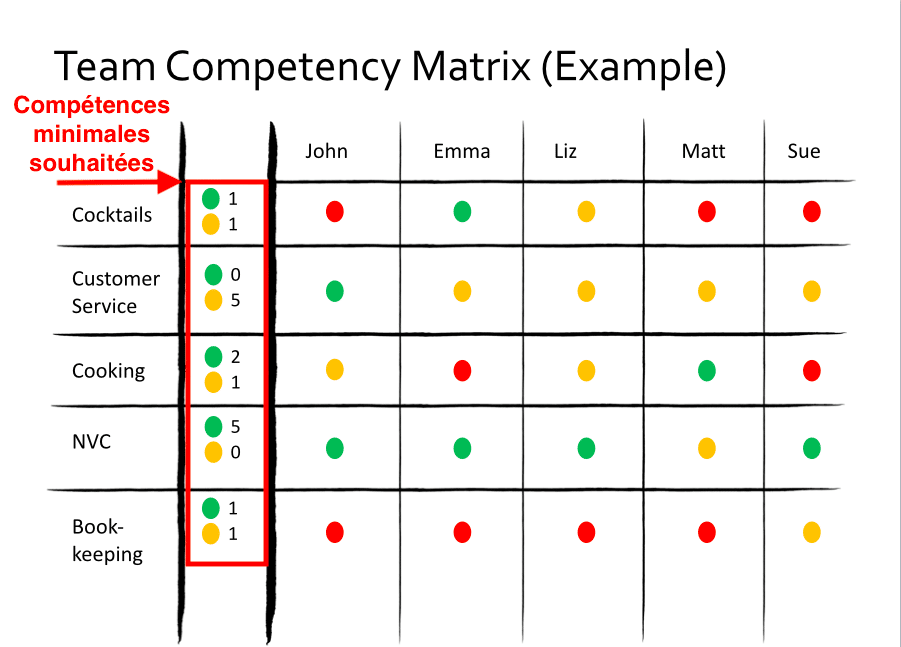
Pour avoir plus de clarté sur la composition de notre équipe, l’utilisation d’une Matrice de Compétence d’équipe peut être particulièrement intéressante. La version proposée par le Management 3.0 me paraît particulièrement utile car elle est simple, visuelle et efficace.
Je vous propose dans cet article de vous décrire son mode de fonctionnement 🙂
Comment l’utiliser ?
Le principe de base est de remplir collectivement la Matrice décrite ci-dessous, dont voici un exemple :

Voyons ensemble les différentes sections pour rendre cela plus explicite. Je vous les décrirai dans la séquence qui me semble la plus cohérente en terme d’animation mais vous pouvez bien évidemment faire autrement 🙂
Section 1 : Activités

Dans cette première section, on y décrit l’ensemble des activités réalisées par l’équipe. Dans l’exemple proposé, l’équipe semble travailler dans un restaurant. Ainsi, on y retrouve les activités suivantes : Cocktails, Service Client, Cuisine, Communication non violente et Comptabilité.
Je trouve intéressant de voir la Communication Non Violente listée ici. En effet, faire apparaître les soft skills peut être une bonne idée pour donner une vision plus globale aux activités de l’équipe.
On voit que le niveau de détails n’est pas particulièrement élevé et cela dépend en fait de vous : plus vous serez précis sur la description des activités, plus les réponses aux questions qui vont suivre seront faciles. Cependant, cela risque d’allonger la liste à un niveau de détail qui n’est peut-être pas nécessaire.
Par exemple : Cocktails pourrait également être décrit comme « Concevoir des cocktails » ou « Réaliser des cocktails« , ce qui pourraient être des activités différentes nécessitant des compétences différentes.
Section 2 : Membres de l’équipe

Dans cette section, rien de bien compliqué, il suffit simplement de lister l’ensemble des membres de l’équipe que vous souhaitez étudier. En effet, la difficulté réside surtout dans le choix du périmètre d’équipe que vous souhaitez étudier.
Est-ce que je considère :
- l’ensemble de l’équipe de réalisation toutes disciplines confondues ?
- l’ensemble des développeurs quitte à faire une autre matrice pour les BAs ?
- des personnes externes qui contribuent ponctuellement ?
Comme à chaque fois, gardez-en tête l’information que vous voulez tirer de l’exercice, cela clarifiera les membres d’équipe à faire apparaître sur cette matrice à ce moment. 😉
Section 3 : Compétences minimales souhaitées

Cette section est pour moi le coeur des conversations intéressantes de l’équipe. Elle se découpe en 2 parties :
- la définition des niveaux de compétences
- la structure minimale nécessaire pour fonctionner sereinement
Définition des niveaux de compétence
Pour la définition des niveaux de compétence, il est usuel d’utiliser une échelle à 3 niveaux. Cela permet simplement d’avoir un niveau intermédiaire entre l’expert et le newbie. Vous pouvez bien évidemment en avoir plus mais est-ce vraiment nécessaire ? 🙂
Un exemple pourrait être :
- Vert : Expert, Autonome sur l’activité, Peut former d’autres sur le sujet
- Orange : A des connaissances suffisantes pour avancer mais peut nécessiter de l’aide
- Rouge : N’y connaît rien, n’a jamais travaillé sur le sujet
Maintenant, l’important réside surtout dans la conversation qui aura lieu pour s’assurer que chacun comprend ce que l’on entend par chaque niveau.
Structure minimale nécessaire
Lorsque les niveaux de compétences ont été définis, on va déterminer la structure d’équipe minimale que l’on pense nécessaire pour que chaque activité se déroule sereinement. On passe alors chaque activité au crible afin d’avoir une vision plus claire des conditions « idéales » pour l’équipe.
Si l’on reprend l’exemple ci-dessus :
- L’activité « Cocktail » nécessite une personne de niveau vert et une de niveau orange
- L’activité « Service Client » nécessite 5 personnes de niveau orange mais de niveau vert
- …
Important à noter : on parle bien de la structure d’équipe minimale, ce qui implique que le total n’a pas besoin d’être égal au nombre de membres de l’équipe. En effet, c’est en échangeant sur l’importance de l’activité par rapport aux enjeux de l’équipe que vous vous rendrez compte du curseur réaliste à placer.
Maintenant, gardez en tête que rien n’est figé dans le marbre et que cela sera quoi qu’il arrive un bon point de départ pour calibrer l’équipe !
Section 4 : Auto-évaluation

Lorsque chaque activité a sa structure minimale définie, on peut passer à l’auto-évaluation de chaque membre de l’équipe. Ainsi, chaque personne indique pour chaque activité son niveau de compétence comme il/elle le perçoit.
D’ailleurs, c’est un facteur important à prendre en compte pour utiliser les résultats à bon escient. En effet, on pourrait ajouter ici une phase de partage où chacun pourrait donner son avis sur l’évaluation des uns et des autres pour affiner la grille.
Pour le coup, je ne le fais jamais car c’est une imprécision que je considère acceptable. D’ailleurs je considère (peut-être à tort) que les personnes ont plus tendance à se sous-évaluer qu’à se sur-évaluer ce qui amène sur le terrain à de bonnes surprises ! 😉
Quoi qu’il en soit, l’exercice se fait généralement de manière individuelle et ne nécessite pas beaucoup de temps (entre 5 et 10 minutes). Cela dépend bien évidemment du nombre d’activités que vous aurez listées !
Débriefing
Lorsque la matrice est complètement remplie, on passe alors à la phase de débriefing où l’on va comparer les structures minimales à la réalité effective de l’équipe. On pourra ainsi voir les domaines d’activité où l’équipe est plutôt sereine et ceux sur lesquels mettre un plan d’actions en place.
Dans notre exemple, on voit que :
| Activité | Commentaires |
| Cocktail | Bon compte minimal. A priori, pas besoin d’agir à cet endroit. |
| Service Client | Meilleure structure de compétence que nécessaire. A priori, pas besoin d’agir à cet endroit. |
| Cuisine | On pourrait se focaliser sur la montée en compétence de John ou Liz. Une autre piste serait de faire monter Sue et Emma mais cela ne semble pas être un besoin immédiat |
| Communication Non Violente | Bon niveau de compétence global dans l’équipe. Seul Matt n’a pas le niveau d’expertise requis pour la structure minimale. On peut supposer que la communication est un enjeu important pour l’équipe ce qui peut faire de cette activité une priorité. On pourrait alors aider Matt à progresser pour augmenter la capacité de l’équipe à communiquer sainement et sereinement, tant en interne qu’en externe. |
| Comptabilité | Domaine visiblement un peu délaissé par l’équipe. Il peut être nécessaire de questionner l’importance de cette activité pour l’équipe et d’agir en conséquence. On pourrait tout à fait imaginer déléguer cette activité à quelqu’un d’autre par exemple si cela est le choix de l’équipe et qu’elle en a les moyens. |
Conclusion

La matrice de compétence d’équipe est un excellent moyen pour améliorer concrètement le fonctionnement d’un collectif. Plus que le résultat, c’est l’exercice en lui-même qui aide à consolider l’équipe.
En effet, son côté réflexif permet de prendre du recul et d’établir les bonnes bases de conversation entre les membres. De plus, cet outil a l’avantage d’être visuel et donc facile à comprendre et à appréhender par les participants. Enfin, l’animation est facilitée par la structure même de la matrice qui peut aider au séquencement des actions et des réflexions.
Je vous invite donc à le tester avec vos équipes et à m’en donner des nouvelles ! 🙂
Pour ma part, je vous proposerai dans un autre article, une utilisation contextualisée de cet outil.







2 réponses
On peut complexifier un peu l’exercice en rajoutant le désir vis-à-vis de l’activité. Certaines personnes peuvent être compétentes sur une activité et ne plus vouloir le faire. A l’inverse, d’autres sont peu compétences et ont le désir de se renforcer. On détecte ainsi le plan de formation interne à l’équipe.
Oui tout à fait ! Je pense que comme pour chaque atelier, l’exercice est un support de conversation pour une intention particulière. C’est cette dernière qui permettra plus facilement d’ajuster les questions et l’orientation que l’on voudra donner pour être plus juste, au bon moment.
Merci pour ta contribution Thierry 🙂
Olivier